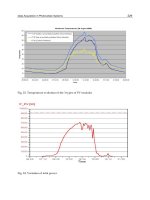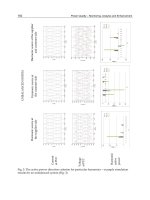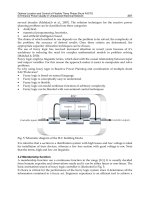Vibration Analysis and Control New Trends and Developments Part 8 potx
Bạn đang xem bản rút gọn của tài liệu. Xem và tải ngay bản đầy đủ của tài liệu tại đây (1.56 MB, 25 trang )
Semi-active Control of Civil Structures Based on the Prediction of the Structural Response: Integrated Design Approach 15
Fig. 5. Optimal control design parameters
Fig. 6. BCJL2 wave (PGA=4.0 [m/s
2
])
165
Semi-Active Control of Civil Structures
Based on the Prediction of the Structural Response: Integrated Design Approach
16 Will-be-set-by-IN-TECH
Fig. 7. Time histories of r
15
and a
15
for BCJL2 wave (Optimized structure, PGA=4.0 [m/s
2
])
××
×
×
Fig. 8. Time histories of the variable damping coefficients of VCDs for BCJL2 wave
(Optimized structure PGA=4.0
[m/s
2
])
166
Vibration Analysis and Control – New Trends and Developments
Semi-active Control of Civil Structures Based on the Prediction of the Structural Response: Integrated Design Approach 17
Fig. 9. RMS values of the relative displacement RMS(r
k
), k = 1, ,15(BCJL2wave)
167
Semi-Active Control of Civil Structures
Based on the Prediction of the Structural Response: Integrated Design Approach
18 Will-be-set-by-IN-TECH
Fig. 10. RMS values of the absolute acceleration RMS(a
k
) , k = 1, . . . , 15 (BCJL2 wave)
168
Vibration Analysis and Control – New Trends and Developments
Semi-active Control of Civil Structures Based on the Prediction of the Structural Response: Integrated Design Approach 19
Fig. 11. Peak values of the relative displacement max
|
r
k
|
, k = 1, . . . , 15 (BCJL2 wave)
169
Semi-Active Control of Civil Structures
Based on the Prediction of the Structural Response: Integrated Design Approach
20 Will-be-set-by-IN-TECH
Fig. 12. Peak values of the absolute acceleration max
|
a
k
|
, k = 1, ,15(BCJL2wave)
170
Vibration Analysis and Control – New Trends and Developments
Semi-active Control of Civil Structures Based on the Prediction of the Structural Response: Integrated Design Approach 21
6. Conclusion
In this chapter the integrated design of civil structural systems and the semi-active control law
is considered. The vibration control device (VCD) that is under development by the authors
is adopted for the semi-active control. The VCD is the mechanism consists of the ball-screw
and the flywheel that is for the inertial resistance force and the electric motor and the electric
circuit for the damping resistance force with the variable damping coefficient. The semi-active
control based on the one-step ahead prediction of the structural response is proposed. With
the predictive semi-active control the stiffness property of the building, the parameters of
VCDs and the weighting matrix used in the semi-active control are simultaneously optimized
so that the control performance on vibration suppression for various recorded and artificial
earthquake disturbances is optimized. The Genetic Algorithm is adopted for the optimization.
The simulation study is conducted for the fifteen story building. The performance on vibration
suppression of the semi-active control system obtained by the integrated design method is
verified with the earthquake wave that is not employed in the GA-based optimization. The
result of the simulation study shows the effectiveness of the proposed design methodology
and the importance of the integrated design approach for control system design including
semi-active control.
The future research subjects are summarized as follows:
• Integrated design of the semi-active control system including the optimization of the
location of the VCDs
• Semi-active control for a simplified model of the real structural system
• Experimental study using a full-scale building with VCDs
7. References
Casciati, F., Magonette, G., & Marazzi, F. (2006). Technology of Semiactive Devices and Application
in Vibration Mitigation, Wiley, New York.
Dyke, S.J., Spencer, Jr., B.F., Sain M.K. & Carlson J.D. (1996). Modeling and control of
magnetorheological dampers for seismic response reduction, Smart Materials and
Structures, Vol. 5: 565-575.
Gavin H.P. (2001). Control of seismically excited vibration using electrorheological materials
and Lyapunov methods, IEEE Transactions on Control Systems Technology, Vol. 9: 27-36.
Grigoriadis, K.M., Zhu, G. & Skelton, R.E. (1996). Optimal Redesign of Linear Systems,
Transactions of the ASME, Journal of Dynamics, Systems, Measurement and Control, Vol.
118: 598-605.
Hiramoto, K., Doki, H. & Obinata, G. (2000). Optimal Sensor/Actuator Placement for Active
Vibration Control Using Explicit Solutions of Algebraic Riccati Equation, Journal of
Sound and Vibration, Vol. 299: 1057-1075.
Hiramoto, K. & Grigoriadis, K.M. (2006). Integrated Design of Structural and Control Systems
with a Homotopy Like Iterative Method, International Journal of Control, Vol. 79:
1062-1073.
Karnopp, D., Crosby, M.J., & Harwood, R.A. (1974). Vibration control using semi-active force
generator, Transactions of the ASME, Journal of Engineering for Industry, Vol. 96: 619-626.
Kurata, N., Kobori, T., Takahashi M., Niwa N. & Midorikawa H. (1999). Actual seismic
response controlled building with semi-active damper system, Earthquake Engineering
& Structural Dynamics, Vol. 28: 1427-1447.
171
Semi-Active Control of Civil Structures
Based on the Prediction of the Structural Response: Integrated Design Approach
22 Will-be-set-by-IN-TECH
Ohtake T., Sunakoda K. & Matsuoka, T. (2006). Study on vibration control device using power
generator, Proceedings of ASME PVP 2006, Vancouver, #PVP2006-ICPVT-11-93534.
Iwata, N., Hama, T. & Soda, S. (1999). Seismic control of the soft-first-story building by sifting
method in sliding mode control, Journal of Structural and Construction Engineering,
(No. 816): 83-90.
Onoda, J. & Hattka R.T. (1987). An Approach to Structure/Control Simultaneous Optimization
for Large Flexible Spacecraft, AIAA Journal, Vol. 25: 1133-1138.
Sodeyama, H., Suzuki, K. & Sunakoda, K. (2004). Development of large capacity semi-active
seismic damper using magneto-rheological fluid, Transactions of the ASME, Journal of
Pressure Vessel Technology, Vol. 126: 105-109.
Spencer, B.F., Dyke, S.J. & Deoskar, H.S. (1998). Benchmark problems in structural control:
Part I - Active mass driver system, Earthquake Engineering & Structural Dynamics, Vo l.
27: 1127-1139.
172
Vibration Analysis and Control – New Trends and Developments
9
Seismic Response Control Using
Smart Materials
Sreekala R, Muthumani K, Nagesh R Iyer
CSIR/Structural Engineering Research Centre
India
1. Introduction
Earthquakes are highly destructive natural phenomena resulting in the massive
deterioration of civil infrastructure, which becomes highly significant wih increasing urban
population.
Performance of structural systems needs to be improved recalling the huge loss
of life and destruction to constructed facilities caused by various earthquakes. Protection of
lifelines and infrastructural facilities are of utmost importance during a seismic event. There
have been considerable research efforts in seismic vibration control for the past several
decades. Developments of new techniques and new materials, which are not traditionally
used in civil engineering structures, offer significant promise in reducing the seismic risk.
Smart materials may be described as materials that can sense an external stimulus (e.g:-
stress, pressure, temperature change, magnetic field, etc.) and initiate a response. They may
belong to one of the four classes namely metals or alloys, polymers, ceramics or composites.
Metals and alloys of different metals are considered as classical materials with lot of
research activities around the globe . Shape Memory Alloys (SMA) belongs to the class of
smart materials which are well known for its peculiar characteristics, which can be stress or
temperature, induced. The research area which deals with structural applications of this
variety of smart materials are promising (Sreekala& Muthumani, 2009) for structural health
monitoring and vibration control.
Nickel Titanium (NiTi) Alloys are well known for its super elastic and shape memory
properties and they belong to the class of Shape Memory Alloys (SMA). Presently SMA’s are
mainly applied in medical sciences, electrical, aerospace and mechanical engineering and
also can open new applications in civil engineering specifically in seismic protection of
buildings.
Super elastic nitinol is found to be very effective for passive vibration control, as
it can sustain large amounts of inelastic deformation and recover that deformation at the
end of the process with good energy dissipation compared to regular metallic materials.
Various tests are conducted on NiTi wires in CSIR-SERC to evaluate the possibility of using
SMA as an energy dissipating material with re-centering capabilities. Ability to sustain and
recover large amounts of inelastic deformation during reversed cyclic loading with extra
ordinary fatigue resistance make super elastic NiTi suitable candidate for seismic risk
reduction. Quasi static and dynamic tests conducted with various parameters like pre strain,
amplitudes and frequency for a number of cycles establishes the behavior which is suitable
for seismic applications. It is interesting to find that from the quasi-static behavior of the
material an optimum value of pre strain, which is material dependent, can be selected and
Vibration Analysis and Control – New Trends and Developments
174
adopted in vibration control applications. Mathematical models were developed to predict
the maximum energy dissipation capability of the material under study. The tests verify the
potential of pre-strained NiTi wires as kernel components in seismic protection devices. It
also highlights the effects of repeated cycling on pre strained wires, as special devices for
passive protection during earthquake are meant for repeated cycling. Various types of
vibration control devices can be made with the material used.
The technologies using smart materials are useful for both new and existing constructions.
The chapter highlights various structural applications of this class of smart materials
available in addition to the suitability of this material for vibration control applications
.
.
Protection of structures from damage during earthquakes can be addressed using passive
protection devices designed to have maximum energy dissipation capacity with re centering
capabilities. Innovative means of structural control scheme can be developed through
passive systems, consisting of materials and devices useful in the context of seismic design
and retrofit of structures
Ductility and energy dissipation are important parameters to be evaluated and quantified
for seismic resistant design of structural components. Equivalent viscous damping is a
significant quantity usually employed in earthquake engineering to characterize the
dissipation capability of the material under investigation. This parameter expresses the
effectiveness of the material in vibration damping. The relevance of the study is made clear
with the associated terms in earthquake engineering
2. Properties, which enable SMA for civil engineering application
1. Repeated absorption of large amounts of strain energy under loading without
permanent deformation
2. Possibility to obtain a wide range of cyclic behaviour from supplemental and fully re
centering to highly dissipating by simply varying the characteristics of SMA components.
3. Strain range of 2 to 10%
4. Extraordinary fatigue resistance under large strain cycles.
5. Their greater durability and reliability in the long run.
2.1 Shape memory alloys in structural control
The existence of SMA property in certain alloys has been known from 1932(when it was first
observed in Gold-Cadmium alloy exhibits a rubber like behavior). SMA’s have unique
properties, which are not present in many materials traditionally used in engineering
applications; especially shape memory effect and super elasticity. While shape memory
alloys have been commercially available since the 1960s, their application has been limited
(Pelton et al., 2000). Early literatures on SMA materials shows successful uses of these for
the design of biomedical and clinical devices, particularly for fixing body fractures
internally with various ‘NiTi’ SMA interlocking intramedullary nails(Da et al,2001). Among
other designs, research related to the use of SMA materials as micro-pumps, micro-grippers,
flexible SMA active catheters, micro nano-tribological devices and SMA thin films for
electromechanical system have been increasingly revealed in recent years (Stockel & Melzer,
1995). Those achievements exhibited an excellent reliability and confidence in using these
materials for other primarily structural elements. The SMA materials possess many unique
mechanical and geometrical properties such as shape memory effects which provide a large
recovery strain and force simultaneously, pseudo-elastic behavior upon heating and super-
Seismic Response Control Using Smart Materials
175
elastic properties in ambient conditions for specified SMA materials. Birman (1997) and
Humbeeck (2001) gave comprehensive reviews on the properties of SMA materials. Based
on the studies under MANSIDE project, 1999(Italian Department for National technical
services) Ni–Ti SMA’s appear to be the best candidates for use in seismic applications. But
selection of the SMA wires for energy dissipation with or without pre strain had to be
addressed separately (Sreekala et al., 2010). So the need arose for finding the effect of pre
strain as well as repeated cycling in the energy dissipation of SMA wires.
2.2 Mechanism behind super elasticity
Super elasticity is related to the isothermal response of SMA specimens to applied
mechanical loads. The phase transformations are solid to solid diffusionless processes
between a crystallographically more ordered phase, the austenite (A) and a
crystallographically less ordered phase the martensite (M). Fig. 1 shows a schematic stress–
strain cyclic curve of a super elastic SMA. It is characterized by five branches. Branches 1
and 4 correspond to the elastic deformation of the two stable phases of SMA, respectively,
austenite and martensite. Branches 2 and 3 correspond, respectively, to the forward (from
austenite to detwinned martensite) and inverse (from detwinned martensite to austenite)
phase transformation. Branch 5 corresponds to the onset of plastic deformation of
detwinned martensite. In the figure
Fs
and
Ff
represent the critical stresses at which the
forward transformation, respectively, starts and finishes, while
Is
and
If
are those at which
the inverse transformation, respectively, starts and finishes. Since loading and unloading
paths are different from each other, a certain amount of energy is dissipated over the cycle.
3. Research significance
Most of the applications of SMA have focused on developing various types of actuators.
However, most of the commercially successful applications - such as couplings, electrical
connectors, cardiovascular stents and eyeglass frames - use the full shape- memory effect or
the full super elastic cycle only a few times. This indicates that SMA components can be
used successfully for several non-actuator applications as well. One such area is the use of
SMA components for damage control in structures. The SMA component can undergo finite
deformations either due to super-elasticity or due to rearrangement of martensite variants at
relatively small stresses. This can be used to prevent permanent plastic deformation due to
unexpected loads in the rest of the structure. The ability of the SMA component to recover
its original dimensions may be an additional advantage, during the seismic events.
Shape Memory Alloys (SMA) show the potential to eliminate some limitations involved in
present technologies, allowing a broader application. The limitations of existing
technologies for passive protection devices can be summarized as follows
1. Problems related to ageing and durability (e.g., rubber components)
2. Difficulty in maintenance(those based on fluid viscosity)
3. Installation complexity or replacement and geometry restoration after strong events
(those based on steel yielding or lead extrusion)
4. Variable performances depending on temperature(polymer based devices)
The usable strain range in the order of 10% in shape memory alloys provide them very high
energy dissipation per unit mass of material. Comparing the well known rubber isolators
and steel hysteretic dampers which belong to the class of quasi-elastic devices and elasto-
plastic devices respectively, re-centering devices gain the best mechanical characteristics of
Vibration Analysis and Control – New Trends and Developments
176
both. The shortcomings of the traditional restrainers can potentially be addressed with the
use of SMAs (Fig.2). The comparative behaviour of steel, rubber and SMA is given in Fig.2.
Fig. 1. Stress-strain curve showing super elasticity of SMA-Schematic sketch describing the
phase change with the deformation process and the associated crystal structure
On the one hand, they recover the initial position of the structure, with a good control of the
displacements; on the other hand they put a threshold to the force transmitted to the super-
structure. The full possibility of designing the mechanical behavior combining the self-
centering and the energy dissipation capability, permit to calibrate the desired features and
fit the specific needs. The availability of such features opens considerable room for
improvement of the structural system design. But the mechanical behavior of SMAs is
strongly dependent upon the alloy composition and the thermo-mechanical treatment.
Special care should be taken while alloy selection is made.
Seismic Response Control Using Smart Materials
177
SMA
STEEL
RUBBER
Fig. 2. Comparative behaviour of Steel, Rubber and SMA
4. Experimental investigation and inferences
The experimental tests were carried out on austenite wire samples of 0.4mm diameter and
1.2mm. The wires were available in spool form. The typical photograph of the material –
wires in spool form-is shown in fig.3. The compositions of wires were NiTi alloy with 55 %
Ni and balance titanium spooled NiTi. The wire selection is made in such a way that Ni-Ti
alloy wire with equi-atomic composition possesses better dissipation property and higher
resistance to corrosion and fatigue. The material is straight annealed super elastic NiTi wires
and has its latent heat and specific gravity 14500 J/kg and 6479.85 kg/m
3
(0.234 lbs/in
3
)
respectively. The test was carried out under ambient temperature conditions around 27
0
C.
Quasi-Static and dynamic tests were conducted to evaluate the super-elastic properties and
energy dissipation capabilities under ambient temperature. Dynamic tests were carried out
by applying sinusoidal cyclic deformation to wire samples. A displacement controlled test
set up was used to perform the tests. The typical test sequence is characterized in terms of
number of cycles, strain amplitude and frequency as they could provide very important
information regarding earthquake applications.
The test programme on SMA wires of two diameters namely 0.4 and 1.2 mm can be
summarized as follows:
1. Quasi-static tests
2. Dynamic tests -frequency of operation 0.5 Hz (sinusoidal cyclic deformation)
a. Tests to evaluate the number of cycles to failure for a constant amplitude
b. Variable amplitude tests to evaluate the energy dissipation capability for increased
amplitudes.
3. Tests on pre-strained wires –frequency of operation 0.5 Hz .
4. Tests on wires for varying frequencies.
The quasi-static (slow rate) tests were performed till the failure of the specimen. The test
was run in a position controlled test set up at constant rate of loading 0.025mm/sec. Fig.4
shows the stress strain curve for quasi-static loading. It is compared with the behavior of
the 1mm diameter steel wire which is used for binding purposes in construction A
sinusoidal cyclic test on SMA wires was performed for maximum amplitude of 5 mm.
Vibration Analysis and Control – New Trends and Developments
178
Fig. 3. The photograph of the super elastic SMA wire samples (Available in spool form)
-0.02 0.00 0.02 0.04 0.06 0.08 0.10 0.12 0.14 0.16
0
200
400
600
800
1000
1200
NiTi -SMA-0.4mm Dia.
Mild Steel-1mm Dia.
Stress-MPa
Strain
Fig. 4. Behaviour of Ni-Ti wires – quasi static tests- Comparison with 1 mm mild- steel
binding wire used for reinforcement stirrup tying in structural construction.
The mechanical behavior such as the transformation stress levels, fatigue behaviour and the
frequency dependence were found to be similar in both diameter wires. The tests were also
carried out with increasing number of cycles to obtain the fatigue characteristics.
Typical load deformation characteristics of 1.2mm diameter wire with 11 mm amplitude are
shown in Fig.6. As the displacement amplitude increased as observed in the force
deformation behaviour, presence of the martensitic phase -after completion of the phase
transformation- provides additional stiffness. Strain hardening is observed towards higher
amplitudes which correspond to 8-9% strain in both the wires seen in Fig.4 & Fig.6. The
increase in stress levels is quite evident in Fig.6. Here cycling up to 9% strain variation
fetches a stress of 830 Mpa.
Seismic Response Control Using Smart Materials
179
Fig. 5. Load deformation curves for 0.4mm diameter wire with 5mm amplitude (strain
variation 3%, maximum stress 650 Mpa)- frequency of loading 0.5 Hz-0.4mm diameter
wires
0
20
40
60
80
100
-5 0 5 10 1
5
Deformation(mm)
Load(Kg)
11 mm cycles
Fig. 6. Load-deformation curves for 1.2 mm diameter wire with 11mm amplitude cycles
(strain range 9%, max. stress 830MPa)- frequency of loading 0.5 Hz Cycles (strain range 9%,
max. stress 830MPa)
The various parameters and the testing scheme are selected in a way to understand the
behavior of the material during earthquakes. Initially a sinusoidal cyclic test on SMA wires
was performed for constant amplitude of 5 mm [ Fig.7(a)- 7(d)]. Usually earthquake
Vibration Analysis and Control – New Trends and Developments
180
vibrations are dynamic- reversed cyclic in nature which consists many number of cycles.
The tests were also carried out with increasing number of cycles to obtain the fatigue
characteristics. Further tests were carried out with increasing amplitude from 5 mm to 11
mm [i.e increasing the total strains from 4% to 9%, Fig.7 (e)]. Strain measurements were
based on the actuator displacement as the wires were having very smooth oxide finish
surface
(a)
(b) Initial 28 cycles (c) Subsequent cycles
Seismic Response Control Using Smart Materials
181
(d) (e)
Fig. 7. (a) to (d) Cyclic tests on non pre-strained wires cycling for +/- 3 percentage strain
variation (5mm amplitude). (e) Effect of increasing the amplitude beyond 1500 cycles.
Due to the repeated cyclic deformation of the same amplitude it is observed that the
hysteresis loops translate downwards and narrows (Fig.7a-7d). Consequently the stress
levels for the transformation decreases. Energy dissipation capacity under constant
amplitude loading remained same up to 500 cycles, 20% reduction was observed in the next
500 cycles and around 30% reduction towards the failure from the initial value. Effect of
increasing the amplitude beyond 1500 cycles can be observed in figure.7e.
4.1. Effect of pre-strain
The effect of pre-strain was found out by imposing pre-strain amplitude in the wire. The
wire is held at that point of pre-strain and reversed-cycling performed for various
amplitudes (Fig.8b). Like wise for various pre strain values the dynamic tests were
performed by giving sinusoidal deformation to the wire samples (Fig.8a). These tests help to
simulate the characteristics of earthquake loading and understand the behaviour of the
material. The frequency dependence on loading is also investigated during the experiment
(Fig.9). The frequency of loading was varied from 0.5 Hz to 3 Hz, at intervals of 0.5 Hz, since
most of the earthquake applications come within this range. Table.1 gives the test
programme for the nitinol wire and the parameters evaluated in the study are tabulated.
Temperature variation during cycling was observed using a thermocouple for quite a few
cycles.
5. Discussion of test results
Quasi-static tests of the wire clearly shows the super elastic property of the SMA wire. Fig.4.
presents the stress strain curves obtained under quasi-static loading using a hydraulically
driven test system (instron make). The shape of the stress strain curve exhibits some of the
fundamental characteristics of SMA. Test result shows the super elastic property of the SMA
wires in the strain range 2% to 10 %. The initial elastic to plateau transition, that is the
Vibration Analysis and Control – New Trends and Developments
182
transition from linearly elastic to super-elastic occurs at a stress of approximately 597 MPa.
The yield stress of 597 Mpa and ultimate stress of 1100 Mpa is comparable with the
idealized behavior of SMA (Dolce, 1994).
(a)
02468101214
0
2
4
6
8
10
12
14
16
Pre-Strain- 7%
Load (kg)
Displacement (mm)
(b)
Fig. 8. Typical sketch showing the loading and the hysteretic curves obtained at 7% pre-
strain –variable amplitudes.
Seismic Response Control Using Smart Materials
183
If the material is unloaded after being loaded into the super elastic region, the unloading
portion of the stress strain curve does not follow the loading portion, but follows a lower
path back to the origin which indicates the transformation of stress induced martensite back
to the austenite (Fig.5,6). This makes the hysteretic energy dissipation which is an important
parameter to be assessed for earthquake applications and hence in passive control devices.
The super elasticity based applications take advantage of the following features 1) the
possibility of recovering large deformations 2) the existence of a transformation stress
plateau, which guarantees constant stress over non-negligible strain intervals.
The
frequency dependence on loading is also investigated during the experiment (Fig.9). The
frequency of loading was varied from 0.5 Hz to 3 Hz, at intervals of 0.5 Hz, since most of the
earthquake applications come within this range.
It is interesting to note that the number of
cycles for the same amplitude is not sensitive to the frequencies in the range 0.5-3 Hz as
observed in both the diameter wires.
Fig. 9. Typical Cyclic behavior (tension compression tests) of non pre-strained wires for
varying frequencies.
It is reported in the literature that the effect of frequency is negligible in the energy
dissipation in the range of interest 0.5 - 3 Hz for seismic applications (Cardone et al,1999) .
But it is observed from the test that the dissipated energy during the sinusoidal loading at
0.5 Hz is 25 % more than the energy dissipated at 1Hz to 3Hz, which is almost a constant
value. Effect of increasing the amplitude beyond 1500 cycles can be observed in figure.7e.
The high fatigue resistance combined with negligible residual deformation, observed in
SMA material help to reduce the post earthquake repair costs, if dampers are made out
using these.
It is found from the experiment that the hysteresis loops narrow and translate upwards
when there is an increase in strain amplitude, while the branches of the curve relevant to the
Vibration Analysis and Control – New Trends and Developments
184
phase transformations harden, thus yielding an increase in the stress levels (Sreekala et
al,2008). This trend is observed in the case of cycling around 7% pre-strain, as the strain
reaches to 10% the end of the transformation range (Fig.8). This phenomenon is related to
the elastic deformation of the de-twinned martensite found at the end of the phase
transformation. This is true for pre strained wires as well as without pre strained. It is a
favorable aspect in seismic applications as the system stiffens rather than softening, if the
expected design seismic action is exceeded, thus ensuring a good control of displacements.
Constant amplitude tests for many cycles for varying frequencies indicated that there is
slight variation in the shape of the loops. Different heat exchange modalities with ambient
temperature, at different strain rates are the causes of these effects from quasi-static to
dynamic range (0.5-3 Hz). As strain rate increases, the heat-exchange condition increasingly
digresses from the isothermal one. The latent heat of transformation causes the specimen to
self-heat and then increase its average temperature during test. At the same time, during
each loading cycle, the specimen temperature oscillates around an average value, according
to the sinusoidal variation of strain. The temperature variation is found to be 9
0
c.While the
instantaneous temperature of the wire oscillates around the ambient temperature (27
0
c) with
excursions of the order of 9
0
c, the average temperature remains practically unchanged
during all the loading history equal to the ambient temperature.
As a result of the self heating (cooling) there occurs instantaneous increase (decrease) of the
stress required for transformation. It is observed from the test that the dissipated energy
during the sinusoidal loading at 0.5 Hz is 25 % more than the energy dissipated at 1Hz to
3Hz, which is almost a constant value. The hardening of the transformation branches, the
narrowing of the cycle, apparent change in the shape of the loop resulting in a reduced
energy loss all of which are associated with slight temperature variation due to different
heat exchange modalities are caused by the stabilization of the material due to repeated
cyclic loading(Fig.10). Possible increase of average temperature during cycling at higher
strain rates produces an upward translation [Miyazaki et al,1986b].
Stabilization of the material behavior due to repeated cyclic loading also can be observed
from the shape change of the loops in the tests on non-pre strained wires (Fig.10). The effect
of pre-strain is found at 2.5% pre strain applied in the form of deformation to the sample, on
two cyclic strains namely 4 % and 6 % (Fig.11.).
The figure reveals the fact that the hysteresis loops translate upwards as it near the
transformation stress level. The comparison between the energy dissipation capability at
various pre strain under different amplitudes, namely 3mm and 7mm is shown in Fig.12.
It is interesting to find that the quasi-static curve serves as the envelope curve in this process
and as and when the stress reaches the transformation stress level, as marked in fig.12,
further stiffening happens in the material. This is an added advantage for seismic
applications that the material gets stiffen, rather softening to have good control of
displacements. Fig. 12 also shows the hysteresis curve for the wire pre strained at 6% and
cycled between 2 % and 10% along with other strain variations.
Tests on wires pre strained to different levels, indicated a particular value of pre-strain,
from which cycling in the pseudo-elastic range fetches maximum energy dissipation (Fig.8.).
The equivalent viscous damping expresses the effectiveness of the material in vibration
damping. It is calculated based on the average energy dissipated per cycle and the damping
values observed are also found to be significant. Looking into 6% pre strain one can see the
higher equivalent damping values. Cyclic variation of 4% strain on either direction at 6%
pre strain gives higher equivalent damping due to higher energy dissipation (Table.1). An
Seismic Response Control Using Smart Materials
185
0246
0
2
4
6
8
10
1.5Hz-1
st
Cycle
Load(kg)
Deformation
(
mm
)
0246
0
2
4
6
8
10
1.5 Hz 500
th
Cycle
Load(kg)
Deformation(mm)
(a) (b)
0246
0
2
4
6
8
2Hz-1450
-th
cycle
Load(kg)
Deformation(mm)
(c)
Fig. 10. (a) to (c) Changes in the shape of the curve during varying frequencies.
Vibration Analysis and Control – New Trends and Developments
186
Fig. 11. Effect of pre-strain on the energy dissipation (1.2 mm diameter wires)- frequency of
loading 0.5 Hz
-0.02 0.00 0.02 0.04 0.06 0.08 0.10 0.12 0.14
0
200
400
600
800
1000
1200
Quasi-Static
7%-3mm
7%-7mm
6%-7mm
5%-3mm
4%-3mm
3%-2mm
2%-3mm
2%-2mm
Stress(MPa)
Strain
Fig. 12. Cyclic behavior of pre strained wires for varying pre strains. [The legend denotes
pre strain %-reverse displacement cycles from that prestrain (mm)]
Seismic Response Control Using Smart Materials
187
average equivalent damping ratio of 16% was realized during the test [ Sreekala et al, 2008].
It is found to be nearer to half the super-elastic range obtained from quasi-static tests.
Results indicate that if the super elastic wires have to play an energy-dissipating role,
cycling around the threshold pre-strain value within this range is desirable [ Sreekala et
al,2010]. In this case the energy dissipation is dependent on the strain value in the super-
elastic range from where cycling the entire range fetches maximum, as seen in figure 4.
For wires without pre strain, the equivalent damping ratio observed is in the order of 3%.
This is because during cycling, the reverse direction (compressive region) does not
contribute for the energy dissipation in non pre-strained wires. Tests on virgin wires shows
lesser damping and energy dissipation capacity and these results can be compared with
those under MANSIDE project. The design of the SMA based devices can be made by
choosing the mechanical properties such as transformation stress levels/ plateau strength as
design variables. Fig.14 shows the hysteretic behaviour of the different types of devices that
can be developed using the properties of the SMA material. A variety of hysteretic
behaviour can be obtained from the material tested and its application can be made suitable
for seismic devices like re-centering, supplemental re-centering or in the case of non re-
centering devices. These results reveal the suitability of using pre strained SMA wires in
vibration control applications, especially for Non Re-Centering Devices-NRCD as seen in
Fig.14. Normally pre straining of wires in vibration control devices requires highly skilled
labour and maintenance becomes a difficult procedure. As far as the numbers of cycles are
concerned, pre strained wires also goes beyond 900 cycles under constant amplitude
loading. e.g.:-in 6% pre strained wire, under the maximum pseudo-elastic range goes up to
940 cycles before failure. No reduction in the energy dissipation is observed up to 30 cycles,
but towards the failure 30 % reduction is observed as in non-pre strained wire. Usually for
seismic applications, the numbers of cycles to be considered are less than 500 cycles as per
various codal spectrums for seismic design in different countries. Table 1 summarizes the
number of cycles, energy dissipation capacity per cycle, the strain variation and the
equivalent damping. These results reveal the suitability of using SMA wires in seismic
vibration control applications.
The usable strain range of the order of 10% in the alloys provide them very high energy
dissipation per unit mass of material. Re-centering devices gain the best mechanical
characteristics of both quasi-elastic devices (e.g., rubber isolators) and elasto-plastic devices
(e.g., steel hysteretic dampers). On the one hand, they recover the initial position of the
structure, with a good control of the displacements; on the other hand they put a threshold
to the force transmitted to the super-structure. The full possibility of designing the
mechanical behavior combining the self-centering and the energy dissipation capability,
permit to calibrate the desired features and fit the specific needs. The availability of such
features opens considerable room for improvement of the structural system design. Fig 7
indicates the various device options for passive vibration control using this material. But the
mechanical behavior of SMAs is strongly dependent upon the alloy composition and the
thermo-mechanical treatment. Special care should be taken while alloy selection is made.
6. Equivalent viscous damping
Some significant quantities usually employed in earthquake engineering to characterize the
dissipation capability of the material under investigation are equivalent viscous damping,
secant stiffness and energy loss per cycle. The equivalent viscous damping expresses the
Vibration Analysis and Control – New Trends and Developments
188
effectiveness of the material in vibration damping. It is calculated based on the average
energy dissipated per cycle. It is calculated as
eq.
= W
D
/(2 K
S
2
) (1)
-0.02 0.00 0.02 0.04 0.06 0.08 0.10 0.12 0.1
4
0
200
400
600
800
1000
1200
Stress i n whi ch el asti c defor mation of Mar tensi te starts
684 MPa
Quasi-st at ic
5%-3mm
6%-7mm
7%-3mm
7%-7mm
Stress,MPa
Strain
Fig. 13. Cyclic behavior of pre strained wires –maximum energy dissipation when pre-
strained almost at the middle of the pseudo-elastic range. [The legend denotes pre strain %-
displacement cycles (mm)]
(1) (2) (3)
Fig. 14. Load –deformation behavior (Hysterisis curves) for various types of Devices based
on SMA, SRCD-Supplementary Re-Centering Device, NRCD-Non Re-centering Devices, and
RCD-Re-centering Devices









